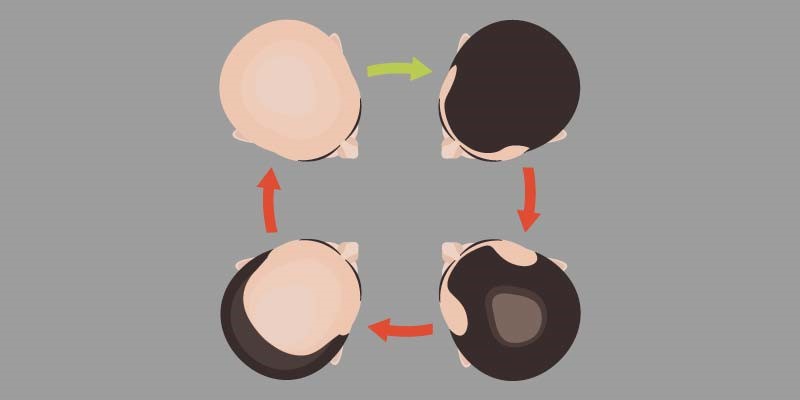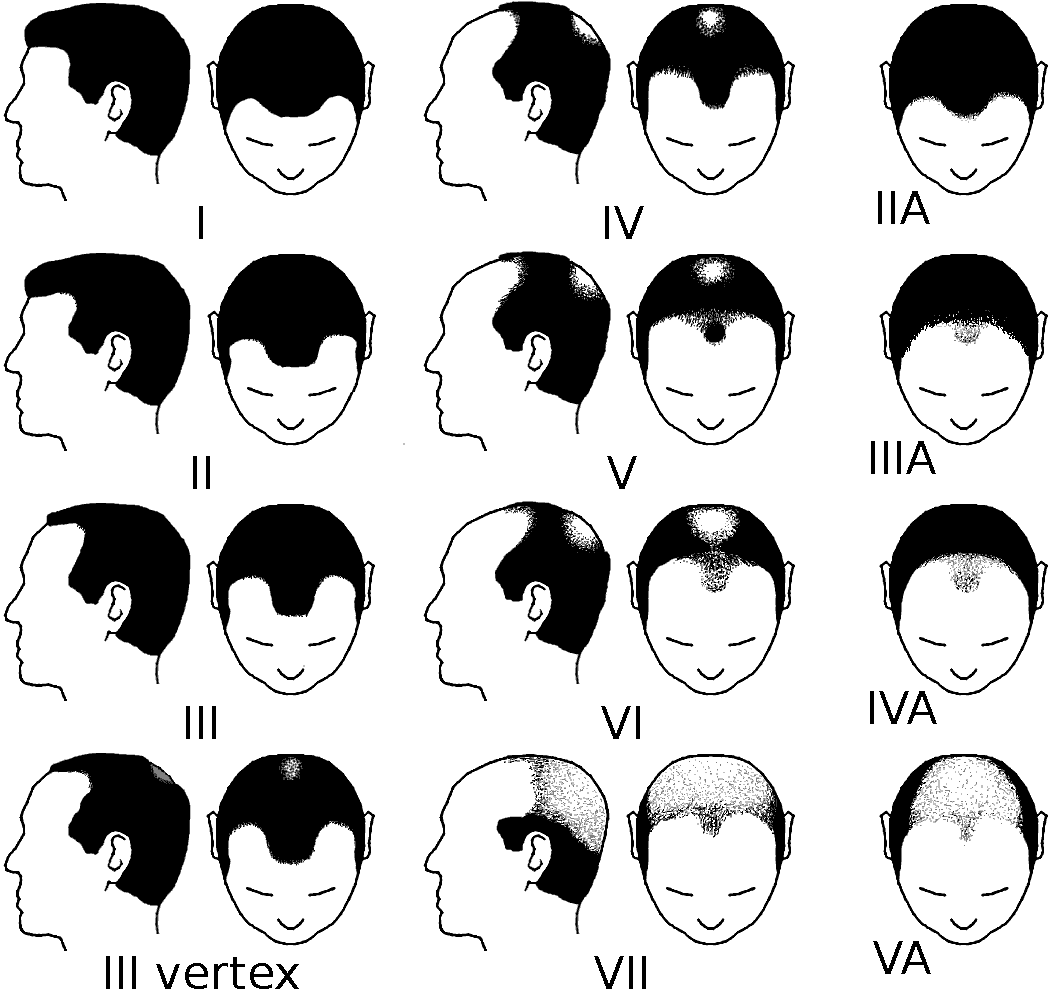Male Pattern Baldness – Causes, Symptoms And Treatments
Male-pattern baldness is a primarily hereditary form of hair loss. According to research, 58% of men in the age group of 30-50 years have experienced male pattern baldness.
What Is Male Pattern Baldness?
Male pattern baldness, also known as androgenetic alopecia, is a progressive hair-thinning condition which ultimately results in the loss of all the hair on the head. Men suffering from MPB start losing hair from their temples, and their hairline starts to recede gradually. In time, the hair at the back of the head or the crown also starts thinning.
Things To Know About Male Pattern Baldness
- More than 55% of men are affected in India.
- Starts with a receding frontal hairline that forms an “M” Shape and Bald patches on the crown of the head.
- A thorough medical history and physical examination by a qualified dermatologist is required.
- It is a chronic condition that can be dealt with easily when it is detected in the early stages.
- 30 – 50 years age group is mainly affected.
What Causes Male Pattern Baldness?
Male pattern baldness is a genetic condition and men can inherit these faulty genes either from one or both parents. Every hair strand on your head goes through a growth cycle. With this hair loss condition, the excess accumulation of DHT on the scalp affects the hair’s growth cycle. As the growth cycle fails to reset, the hair follicles shrink, producing shorter and thinner strands of hair. Over time, the growth cycle of the hair stops completely, and no new hair grows in its place.
Although men usually start losing their hair once they reach the age of 30, it is also possible to be affected by androgenetic alopecia during their teenage years. The sooner it starts, the greater the loss will be if left untreated.
Must Read: What Is The Hair Growth Cycle?
Male Pattern Baldness Symptoms

Male Pattern Baldness Symptoms Are As Follows –
- Excessive hair loss
- Hair becoming thinner with time and ultimately resembling ‘peach fuzz.’
- Reduction in hair density
- Formation of bald patches on the top of the head
- Temple hair loss
- Hair loss on the crown area
- Receding hairline
These can lead to partial and even complete baldness.
What Are The Stages Of Male Pattern Baldness?
The Norwood Hamilton Scale is a standard that is followed worldwide to identify the different stages of androgenetic alopecia. The male pattern baldness stages are as follows –
- Stage 1 – Minimal or no recession of the hairline.
- Stage 2 – Triangular areas of hair thinning begin from the temples on both sides.
- Stage 2A – Temporal hair loss is not very accentuated but is accompanied by hair becoming thinner on the crown.
- Stage 3 – Temporal hair recedes further leaving minimal or no hair at the temples.
- Stage 3A – This is a variant with the deep recession of the frontal hairline in addition to the temples.
- Stage 3A – Hair loss is primarily from the vertex with limited thinning of sides of the hairline.
- Stage 4– Hair on the crown becomes thinner and forms a bridge-like band as the bald patch on the top of the head increases in size. This band connects to a fully-haired fringe on the sides of the scalp.
- Stage 4A – The hair in the frontal area becomes sparser (thinner) with the loss of the connecting band.
- Stage 5 – The bald patch on the top further increases in size and is almost the size of an apple. The bridge-like band becomes thinner, while the frontal hair is present as a disconnected patch in a triangular shape.
- Stage 5A – The bridge-like band disappears leaving behind extremely scanty hair with a receding hairline much like the 4A stage.
- Stage 6 – The frontal and temporal regions join with the patch on the top of the head to form one area with absolutely scanty hair growth. In this stage, the connecting band of hair is almost completely lost.
- Stage 7 – The most severe stage of hair loss where only a narrow band of hair in a horseshoe shape remains on the sides and back of the scalp, with no hair being present in the front and top of the head.

How Is Male Pattern Hair Loss Diagnosed?
To diagnose male pattern hair loss, a dermatologist will conduct various tests such as a scalp skin examination, blood tests (optional) and will inquire about your scalp history, family history of similar hair loss, etc.
How To Treat Male Pattern Baldness?
There are a few treatments and medication available to treat the male pattern baldness condition; however, there is no permanent cure for it. The procedures are effective in slowing down the development of hair loss, and some are also effective in partially restoring the lost hair.
- PRP Hair Treatment – A recent study published in the Journal of Cutaneous and Aesthetic Surgery positively affirmed that PRP hair treatment does work for reversing male pattern baldness. It utilises the growth factors that are naturally produced by blood platelets to improve hair growth from stem cells in the hair follicles which also enhances blood flow. These platelets are obtained by extracting blood from the patient and separating plasma that is rich in platelets. A fine needle injection is utilised to introduce this platelet-rich plasma (PRP) into the affected areas of the scalp. Male pattern baldness stages 3 to 5A can be reversed with this treatment along with medical intervention and is a cost-effective treatment.
PRP hair therapy in conjunction with medication is beneficial to delay male pattern baldness. Watch this video to learn how PRP hair treatment works-
Must Read: How Much Does PRP Hair Treatment Cost?
- Minoxidil – This is a US FDA approved topical medication for treating male pattern baldness. Its exact mechanism of action is unknown, but it has been shown to successfully improve hair growth and also, the blood supply to the hair bulbs. This medication shows its best results when used in the initial stages, and continued usage is mandatory. Generally, dermatologists recommend a 5% to 10% concentration of the drug for topical usage. Discontinuing this treatment will revert the hair condition within a few months.
- Finasteride – This is another FDA approved medicine, but unlike minoxidil, finasteride needs to be taken orally. It helps slow down the progression of androgenetic alopecia and causes new hair growth. With positive results among 50-60% of patients showing an improvement in hair count, finasteride has become a widely popular treatment for male pattern baldness. Like minoxidil, one needs to keep taking this medicine to maintain the results.
- Hair Replacement / Transplantation – This treatment is usually a last resort measure. It is an invasive treatment that involves transplanting hair follicles from areas of active hair growth to an area where hair growth has diminished or stopped. As it is a surgical procedure, hair transplantation carries the risk of infection and can be expensive. A skilled dermatologist who performs the procedure with stringent protocols and under hygienic settings can eliminate the chances of any infection. Minoxidil needs to be used continuously to maintain results.
What Are The Before And After Results?
Unfortunately, a permanent male pattern baldness cure does not exist. The treatment options that are available for this hair disorder work only during certain stages. Studies show that the potential for hair regrowth diminishes as androgenetic alopecia progresses. Therefore, early detection and management can help stop the problem from progressing beyond control and keep your hair in prime condition.
Our certified subject matter experts do extensive research and collate facts from reputed scientific journals and international studies to create informative and engaging articles related to all your dermatology concerns. They strive to help you decipher medical jargon, distinguish fact from fiction and overcome paranoia. Our qualified medical board or expert panel goes a step further to verify these facts based on their rich academic knowledge, vast clinical experience and critical industry insights to ensure you consume only medically accurate content that empowers you to make informed decisions about your hair and skin-care treatments and weight management. Check out our Editorial policy for further details
https://www.ncbi.nlm.nih.gov/pmc/articles/PMC2938575/



















